Unit 10 I'd like some noodles. SectionA(GrammarFocus-3c)课件40张
文档属性
| 名称 | Unit 10 I'd like some noodles. SectionA(GrammarFocus-3c)课件40张 | 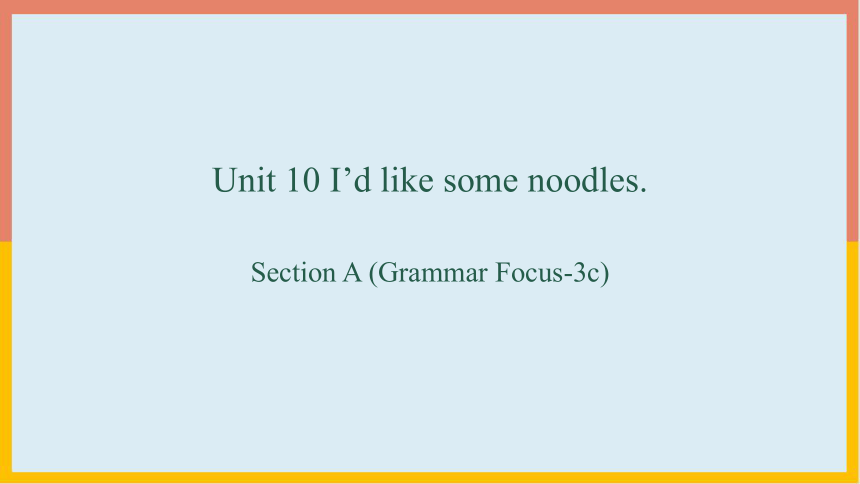 | |
| 格式 | pptx | ||
| 文件大小 | 8.4MB | ||
| 资源类型 | 教案 | ||
| 版本资源 | 人教新目标(Go for it)版 | ||
| 科目 | 英语 | ||
| 更新时间 | 2022-01-02 09:56:40 | ||
图片预览

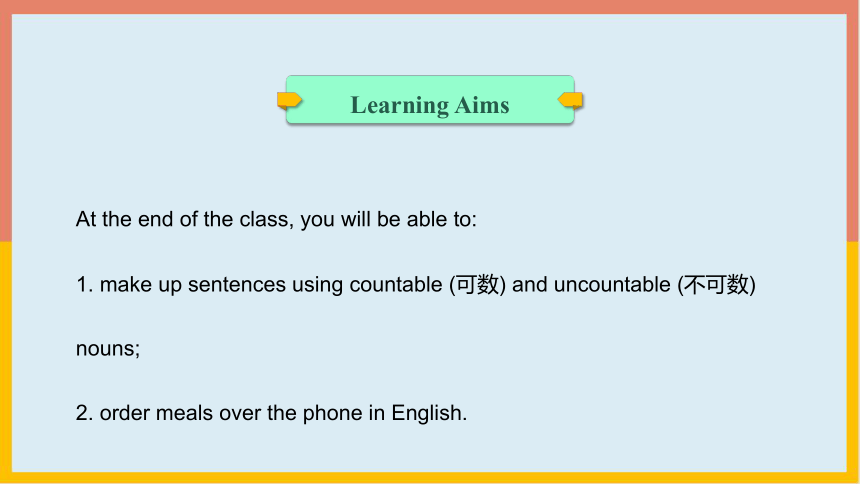
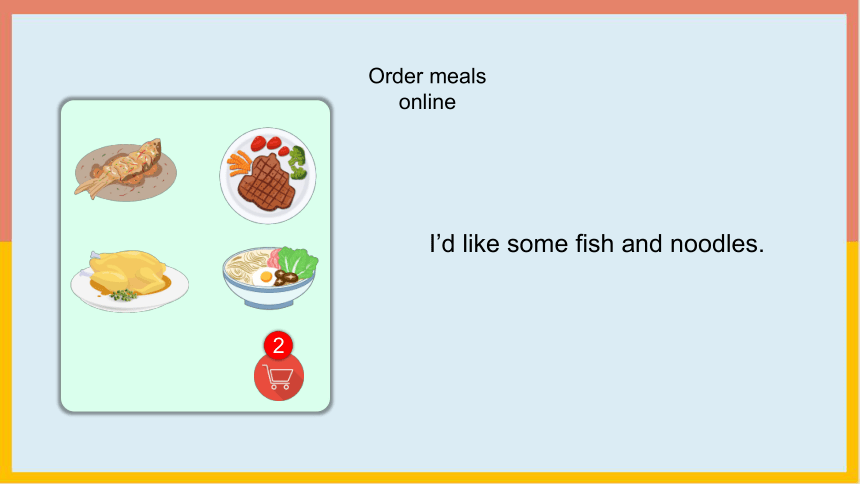

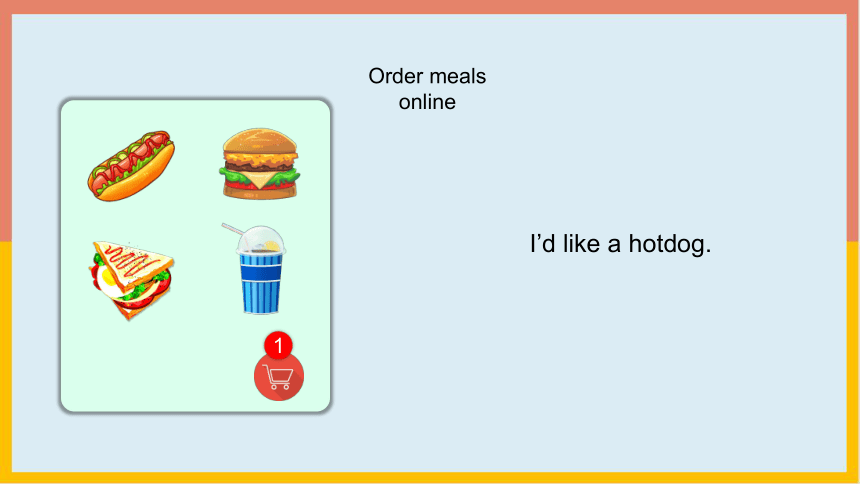
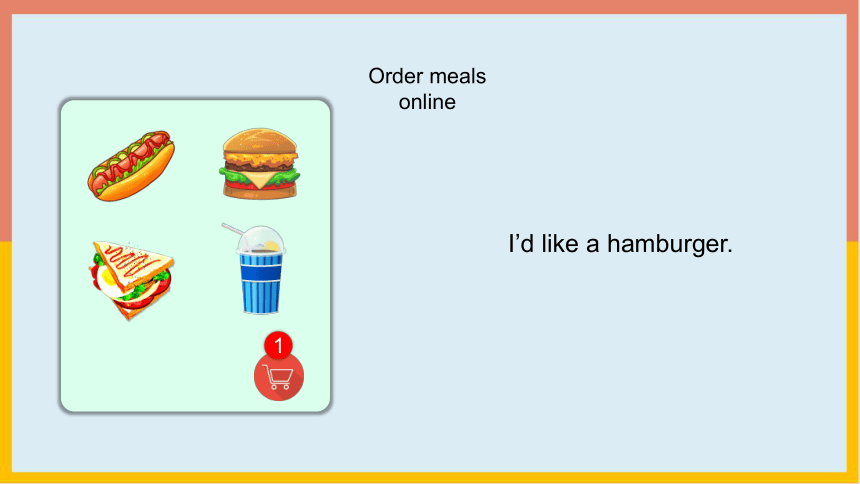
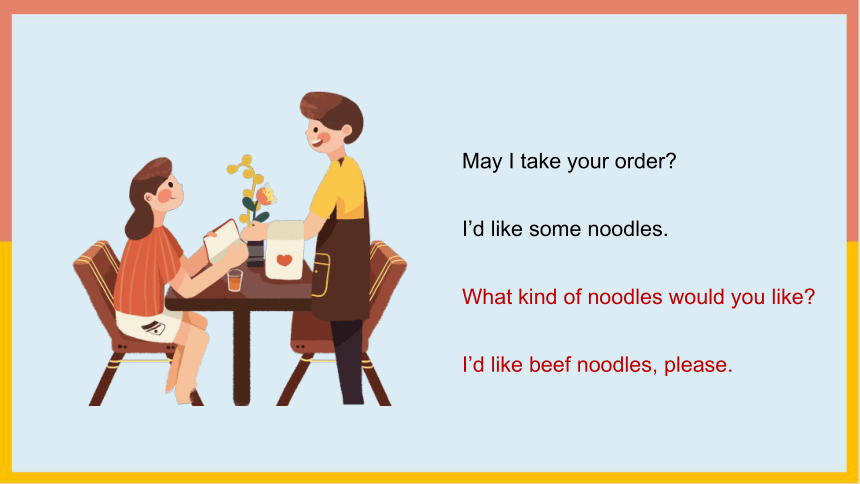

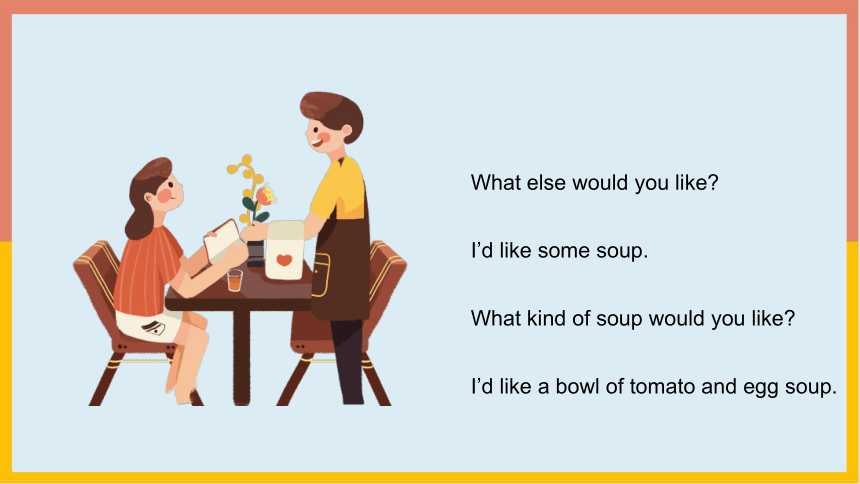
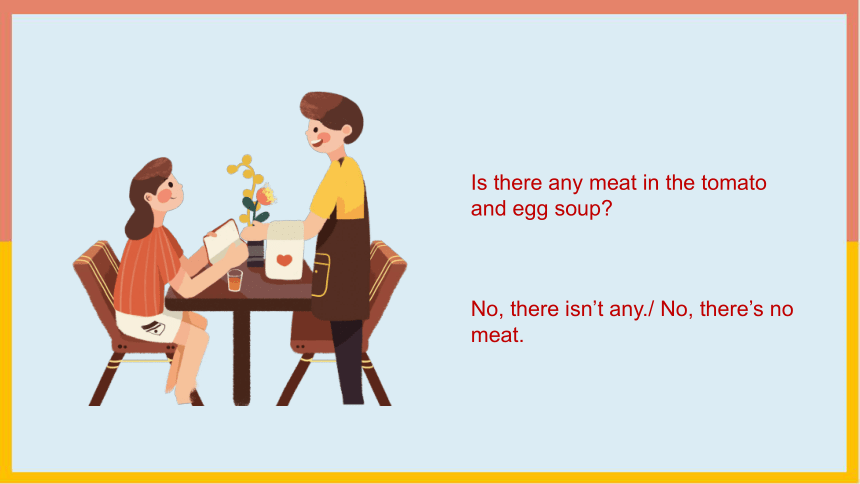
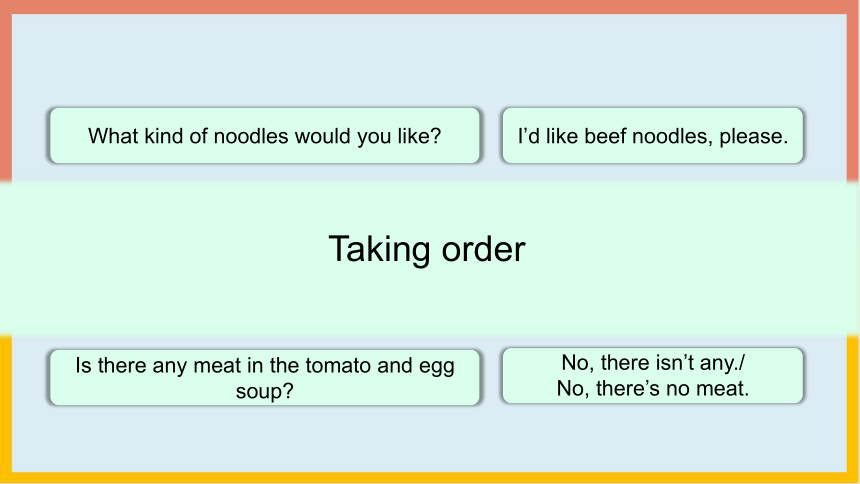
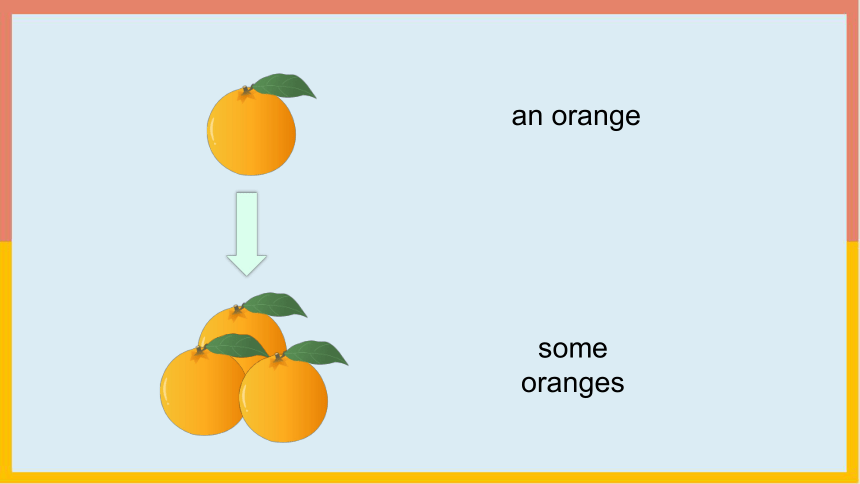
文档简介
(共40张PPT)
Unit 10 I’d like some noodles.
Section A (Grammar Focus-3c)
Learning Aims
At the end of the class, you will be able to:
1. make up sentences using countable (可数) and uncountable (不可数) nouns;
2. order meals over the phone in English.
Order meals online
I’d like some fish and noodles.
1
2
Order meals online
I’d like some chicken.
1
Order meals online
I’d like a hotdog.
1
Order meals online
I’d like a hamburger.
1
May I take your order
I’d like some noodles.
What kind of noodles would you like
I’d like beef noodles, please.
What size would you like
I’d like a large bowl, please.
Would you like a large bowl
Yes, please.
What else would you like
I’d like some soup.
What kind of soup would you like
I’d like a bowl of tomato and egg soup.
Is there any meat in the tomato and egg soup
No, there isn’t any./ No, there’s no meat.
What kind of noodles would you like
What size would you like
Would you like a large bowl
Is there any meat in the tomato and egg soup
I’d like beef noodles, please.
I’d like a large bowl, please.
Yes, please.
No, there isn’t any./
No, there’s no meat.
Taking order
an orange
some oranges
an apple
some apples
a strawberry
some strawberries
a box of milk
some milk
a plate of mutton
some mutton
a glass of juice
some juice
chicken
salad
ice-cream
单数
复数
不可数
uncountable
名词
noun
可数
countable
countable nouns
可数名词
可以计算数目的名词。
a carrot
two carrots
a cucumber
many cucumbers
countable nouns
可数名词
情况 规则 举例
一般情况 直接加s apples, bananas, trees, chairs
以s, x, sh, ch结尾 加es buses, foxes, brushes, watches
以辅音字母+y结尾 去y,再加ies cities, families
可数名词变复数规则:
countable nouns
可数名词
可数名词变复数规则:
以f/fe结尾 去f/fe,变成ves thieves, shelves, wives
以o结尾 加s/es pianos, radios, tomatoes, potatoes
特殊情况 无规则 men, women, children
countable nouns
可数名词
做主语:
(1)主语(单数)+谓语(单数)
(2)主语(复数)+谓语(复数)
My grandma gets up early every morning.
Students at this school all work very hard.
既可作可数又可作不可数的名词
Three little chickens were hatched an hour ago.
Would you like some chicken
There are many oranges in the basket.
I’d like some orange to drink.
既可作可数又可作不可数的名词
做主语:根据主语实际意义,判断谓语动词形式。
Fish is a healthy type of food.
Many fishes are swimming in the pool.
Paper is widely used in industry.
Papers are piled (堆积) on the desk.
鱼(总称)
鱼(个体)
纸类
文件
uncountable nouns
不可数名词
不可数名词是指不能以数目来计算,不可以分成个体的概念、状态、品质、感情或表示物质的材料等。
表示个体意义时,可以用数量词来修饰。
如:a loaf of bread, a glass of juice
uncountable nouns
不可数名词
3.做主语:
(1)单个不可数名词做主语,谓语动词使用单数。
如:Light travels (传播) faster than sound.
(2)多个不可数名词做主语,谓语动词用复数。
如:Fruit and vegetable are good for health.
1. May I have your order ___
2. What kind of noodles would you like ____
3. We have beef, chicken, mutton, cabbage, potato, tomato…____
4. Yes, there are some carrots.___
5. Sure. What size would you like ____
6. We have large, medium and small bowls.____
a: What kind of noodles do you have
b: Oh, a medium bowl, please.
c: OK, I’d like the mutton noodles then.
d: I’d like some noodles, please.
e: What sizes do you have
f: Are there any vegetables in the mutton noodles
d
a
f
c
e
b
3a Complete the conversation below.
Act out the conversation.
A: May I have your order
B: I’d like some noodles, please.
A: What kind of noodles would you like
B: What kind of noodles do you have
A: We have beef, chicken, mutton, cabbage, potato, tomato.
B: Are there any vegetables in the mutton noodles
A: Yes, there are some carrots.
B: OK, I’d like the mutton noodles then.
A: Sure. What size would you like
B: What size do you have
A: We have large, medium and small bowls.
B: Oh, a medium bowl, please.
3b Write questions and answers using the words in brackets.
1.What kind of noodles would you like (kind)
________________________________________(chicken/beef/tomatoes)
2. _________________________(size)
_____________________________(medium)
3. ____________________________________(any/cabbage/beef noodles)
____________________________ (no)
I’d like the chicken/beef noodles with tomatoes.
What size would you like
Are there any cabbages in the beef noodles
I’d like a medium bowl of noodles.
No, there aren’t any cabbages.
3c Work in small groups. Who would like the food below Write their names on the cards above the food.
A: Anna, what would you like to eat
B: I’d like beef noodles with carrots.
I’d like beef noodles with carrots.
我想要胡萝卜牛肉面。
with是介词 ,常见的用法有:
1.意为“带着,有”。
e.g. Do you know that girl with long hair
2.表示伴随,意为“和……一起”。
e.g. He always goes to school with her.
I’d like beef noodles with carrots.
我想要胡萝卜牛肉面。
with是介词 ,常见的用法有:
3.表示手段或方法,意为“用……”。
e.g. He is writing with a pen.
4. take/ bring/ have sth. with sb. 意为“某人随身带着某物”。
e.g. He often brings a book with him.
I’d like tomato and egg noodles.
我想要西红柿鸡蛋面。
tomato and egg noodles中,tomato and egg是定语,修饰noodles。
可数名词作定语时,谓语动词通常用单数。
【注意】当man和woman作定语修饰名词复数时,man或woman也要相应地用复数形式。
e.g.
two men teachers, ten women doctors
large, big与great
large, big与great都有“大”的意思,它们的区别:
large:意为“大的;巨大的”,用来指体积、容积、面积及范围大、数量多,其反义词是small。
big:意为“大的”,侧重于表示一个物体的体积,即“块头、重量”;还可以表示“伟大、重要”等。其反义词是little或small。
great:意为“巨大的 、伟大的”,表示数量多、体积大外,还可以指抽象的事物或精神方面的东西。
口语中big与large可以换用,big比较口语化,large比较正式。指人时一般用big不用large。
Grammar:
点餐:
What kind of noodles would you like
What size would you like
名词的数:
可数名词:单数;复数;
不可数名词;
既是可数名词,又是不可数名词。
根据所给汉语提示完成句子
1. The soup with ________(羊肉) tastes delicious.
2. It's healthy for you to have potatoes and ________ (牛肉).
3. I like vegetables better than ________(肉).
4. Next, put the onion and tomatoes on the ________ (鸡肉).
5. Dumplings, ________(面条) and porridge are my favorite Chinese food.
mutton
beef
meat
chicken
noodles
用括号中所给单词的适当形式填空
1. We have many great ________(special) in the restaurant.
2. I would like you ________(come) to my house.
3. A small bowl of dumplings ________(be) on the table.
4. There are some ___________(tomato) and apples on the table.
5. There ________(be) some meat and vegetables in the noodles.
specials
to come
is
tomatoes
is
根据汉语意思完成句子。每空一词
1. 桌子上有一些西红柿和鸡蛋。
______ ______ ______ _______ and eggs on the table.
2. 我想要一碗牛肉汤。
I’d like ______ _____ ______ beef soup.
3. 你姐姐穿多大尺码的?
_____ ______ does your sister wear
4. 你想要什么种类的面条?
_______ ______ _____ _______ would you like
5. 牛肉汤里有蔬菜吗?
_____ ______ ______ _________ in the beef soup
There are some tomatoes
a bowl of
What size
What kind of noodles
Are there any vegetables
1. Review the grammar we have learnt in this lesson.
2. Make conversations with your partner about ordering food.
Unit 10 I’d like some noodles.
Section A (Grammar Focus-3c)
Learning Aims
At the end of the class, you will be able to:
1. make up sentences using countable (可数) and uncountable (不可数) nouns;
2. order meals over the phone in English.
Order meals online
I’d like some fish and noodles.
1
2
Order meals online
I’d like some chicken.
1
Order meals online
I’d like a hotdog.
1
Order meals online
I’d like a hamburger.
1
May I take your order
I’d like some noodles.
What kind of noodles would you like
I’d like beef noodles, please.
What size would you like
I’d like a large bowl, please.
Would you like a large bowl
Yes, please.
What else would you like
I’d like some soup.
What kind of soup would you like
I’d like a bowl of tomato and egg soup.
Is there any meat in the tomato and egg soup
No, there isn’t any./ No, there’s no meat.
What kind of noodles would you like
What size would you like
Would you like a large bowl
Is there any meat in the tomato and egg soup
I’d like beef noodles, please.
I’d like a large bowl, please.
Yes, please.
No, there isn’t any./
No, there’s no meat.
Taking order
an orange
some oranges
an apple
some apples
a strawberry
some strawberries
a box of milk
some milk
a plate of mutton
some mutton
a glass of juice
some juice
chicken
salad
ice-cream
单数
复数
不可数
uncountable
名词
noun
可数
countable
countable nouns
可数名词
可以计算数目的名词。
a carrot
two carrots
a cucumber
many cucumbers
countable nouns
可数名词
情况 规则 举例
一般情况 直接加s apples, bananas, trees, chairs
以s, x, sh, ch结尾 加es buses, foxes, brushes, watches
以辅音字母+y结尾 去y,再加ies cities, families
可数名词变复数规则:
countable nouns
可数名词
可数名词变复数规则:
以f/fe结尾 去f/fe,变成ves thieves, shelves, wives
以o结尾 加s/es pianos, radios, tomatoes, potatoes
特殊情况 无规则 men, women, children
countable nouns
可数名词
做主语:
(1)主语(单数)+谓语(单数)
(2)主语(复数)+谓语(复数)
My grandma gets up early every morning.
Students at this school all work very hard.
既可作可数又可作不可数的名词
Three little chickens were hatched an hour ago.
Would you like some chicken
There are many oranges in the basket.
I’d like some orange to drink.
既可作可数又可作不可数的名词
做主语:根据主语实际意义,判断谓语动词形式。
Fish is a healthy type of food.
Many fishes are swimming in the pool.
Paper is widely used in industry.
Papers are piled (堆积) on the desk.
鱼(总称)
鱼(个体)
纸类
文件
uncountable nouns
不可数名词
不可数名词是指不能以数目来计算,不可以分成个体的概念、状态、品质、感情或表示物质的材料等。
表示个体意义时,可以用数量词来修饰。
如:a loaf of bread, a glass of juice
uncountable nouns
不可数名词
3.做主语:
(1)单个不可数名词做主语,谓语动词使用单数。
如:Light travels (传播) faster than sound.
(2)多个不可数名词做主语,谓语动词用复数。
如:Fruit and vegetable are good for health.
1. May I have your order ___
2. What kind of noodles would you like ____
3. We have beef, chicken, mutton, cabbage, potato, tomato…____
4. Yes, there are some carrots.___
5. Sure. What size would you like ____
6. We have large, medium and small bowls.____
a: What kind of noodles do you have
b: Oh, a medium bowl, please.
c: OK, I’d like the mutton noodles then.
d: I’d like some noodles, please.
e: What sizes do you have
f: Are there any vegetables in the mutton noodles
d
a
f
c
e
b
3a Complete the conversation below.
Act out the conversation.
A: May I have your order
B: I’d like some noodles, please.
A: What kind of noodles would you like
B: What kind of noodles do you have
A: We have beef, chicken, mutton, cabbage, potato, tomato.
B: Are there any vegetables in the mutton noodles
A: Yes, there are some carrots.
B: OK, I’d like the mutton noodles then.
A: Sure. What size would you like
B: What size do you have
A: We have large, medium and small bowls.
B: Oh, a medium bowl, please.
3b Write questions and answers using the words in brackets.
1.What kind of noodles would you like (kind)
________________________________________(chicken/beef/tomatoes)
2. _________________________(size)
_____________________________(medium)
3. ____________________________________(any/cabbage/beef noodles)
____________________________ (no)
I’d like the chicken/beef noodles with tomatoes.
What size would you like
Are there any cabbages in the beef noodles
I’d like a medium bowl of noodles.
No, there aren’t any cabbages.
3c Work in small groups. Who would like the food below Write their names on the cards above the food.
A: Anna, what would you like to eat
B: I’d like beef noodles with carrots.
I’d like beef noodles with carrots.
我想要胡萝卜牛肉面。
with是介词 ,常见的用法有:
1.意为“带着,有”。
e.g. Do you know that girl with long hair
2.表示伴随,意为“和……一起”。
e.g. He always goes to school with her.
I’d like beef noodles with carrots.
我想要胡萝卜牛肉面。
with是介词 ,常见的用法有:
3.表示手段或方法,意为“用……”。
e.g. He is writing with a pen.
4. take/ bring/ have sth. with sb. 意为“某人随身带着某物”。
e.g. He often brings a book with him.
I’d like tomato and egg noodles.
我想要西红柿鸡蛋面。
tomato and egg noodles中,tomato and egg是定语,修饰noodles。
可数名词作定语时,谓语动词通常用单数。
【注意】当man和woman作定语修饰名词复数时,man或woman也要相应地用复数形式。
e.g.
two men teachers, ten women doctors
large, big与great
large, big与great都有“大”的意思,它们的区别:
large:意为“大的;巨大的”,用来指体积、容积、面积及范围大、数量多,其反义词是small。
big:意为“大的”,侧重于表示一个物体的体积,即“块头、重量”;还可以表示“伟大、重要”等。其反义词是little或small。
great:意为“巨大的 、伟大的”,表示数量多、体积大外,还可以指抽象的事物或精神方面的东西。
口语中big与large可以换用,big比较口语化,large比较正式。指人时一般用big不用large。
Grammar:
点餐:
What kind of noodles would you like
What size would you like
名词的数:
可数名词:单数;复数;
不可数名词;
既是可数名词,又是不可数名词。
根据所给汉语提示完成句子
1. The soup with ________(羊肉) tastes delicious.
2. It's healthy for you to have potatoes and ________ (牛肉).
3. I like vegetables better than ________(肉).
4. Next, put the onion and tomatoes on the ________ (鸡肉).
5. Dumplings, ________(面条) and porridge are my favorite Chinese food.
mutton
beef
meat
chicken
noodles
用括号中所给单词的适当形式填空
1. We have many great ________(special) in the restaurant.
2. I would like you ________(come) to my house.
3. A small bowl of dumplings ________(be) on the table.
4. There are some ___________(tomato) and apples on the table.
5. There ________(be) some meat and vegetables in the noodles.
specials
to come
is
tomatoes
is
根据汉语意思完成句子。每空一词
1. 桌子上有一些西红柿和鸡蛋。
______ ______ ______ _______ and eggs on the table.
2. 我想要一碗牛肉汤。
I’d like ______ _____ ______ beef soup.
3. 你姐姐穿多大尺码的?
_____ ______ does your sister wear
4. 你想要什么种类的面条?
_______ ______ _____ _______ would you like
5. 牛肉汤里有蔬菜吗?
_____ ______ ______ _________ in the beef soup
There are some tomatoes
a bowl of
What size
What kind of noodles
Are there any vegetables
1. Review the grammar we have learnt in this lesson.
2. Make conversations with your partner about ordering food.
同课章节目录
- Unit 1 Can you play the guitar?
- Section A
- Section B
- Unit 2 What time do you go to school?
- Section A
- Section B
- Unit 3 How do you get to school?
- Section A
- Section B
- Unit 4 Don't eat in class.
- Section A
- Section B
- Unit 5 Why do you like pandas?
- Section A
- Section B
- Unit 6 I'm watching TV.
- Section A
- Section B
- Review of Units 1-6
- Unit 7 It's raining!
- Section A
- Section B
- Unit 8 Is there a post office near here?
- Section A
- Section B
- Unit 9 What does he look like?
- Section A
- Section B
- Unit 10 I'd like some noodles.
- Section A
- Section B
- Unit 11 How was your school trip?
- Section A
- Section B
- Unit 12 What did you do last weekend?
- Section A
- Section B
